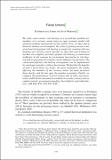Fiscal Unions
Author(s)
Farhi, Emmanuel; Werning, Ivan
Downloadaer.20130817.pdf (1.222Mb)
PUBLISHER_POLICY
Publisher Policy
Article is made available in accordance with the publisher's policy and may be subject to US copyright law. Please refer to the publisher's site for terms of use.
Terms of use
Metadata
Show full item recordAbstract
We study cross-country risk sharing as a second-best problem for members of a currency union using an open economy model with nominal rigidities and provide two key results. First, we show that if financial markets are incomplete, the value of gaining access to any given level of aggregate risk sharing is greater for countries that are members of a currency union. Second, we show that even if financial markets are complete, privately optimal risk sharing is constrained inefficient. A role emerges for government intervention in risk sharing both to guarantee its existence and to influence its operation. The constrained efficient risk-sharing arrangement can be implemented by contingent transfers within a fiscal union. We find that the benefits of such a fiscal union are larger, the more asymmetric the shocks affecting the members of the currency union, the more persistent these shocks, and the less open the member economies. Finally, we compare the performance of fiscal unions and of other macroeconomic stabilization instruments available in currency unions such as capital controls, government spending, fiscal deficits, and redistribution. (JEL E62, F31, F32, F41, F45)
Date issued
2017-12Department
Massachusetts Institute of Technology. Department of EconomicsJournal
American Economic Review
Publisher
American Economic Association
Citation
Farhi, Emmanuel, and Iván Werning. “Fiscal Unions.” American Economic Review 107, no. 12 (December 2017): 3788–3834. © 2017 American Economic Association
Version: Final published version
ISSN
0002-8282
1944-7981